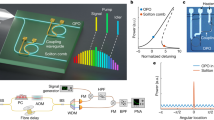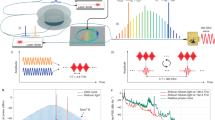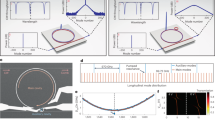Abstract
The phase-coherent frequency division of a stabilized optical reference laser to the microwave domain is made possible by optical-frequency combs (OFCs)1,2. OFC-based clockworks3,4,5,6 lock one comb tooth to a reference laser, which probes a stable atomic transition, usually through an active servo that increases the complexity of the OFC photonic and electronic integration for fieldable clock applications. Here, we demonstrate that the Kerr nonlinearity enables passive, electronics-free synchronization of a microresonator-based dissipative Kerr soliton (DKS) OFC7 to an externally injected reference laser. We present a theoretical model explaining this Kerr-induced synchronization (KIS), which closely matches experimental results based on a chip-integrated, silicon nitride, micro-ring resonator. Once synchronized, the reference laser captures an OFC tooth, so that tuning its frequency provides direct external control of the OFC repetition rate. We also show that the stability of the repetition rate is linked to that of the reference laser through the expected frequency division factor. Finally, KIS of an octave-spanning DKS exhibits enhancement of the opposite dispersive wave, consistent with the theoretical model, and enables improved self-referencing and access to the OFC carrier–envelope offset frequency. The KIS-mediated enhancements we demonstrate can be directly implemented in integrated optical clocks and chip-scale low-noise microwave generators.
This is a preview of subscription content, access via your institution
Access options
Access Nature and 54 other Nature Portfolio journals
Get Nature+, our best-value online-access subscription
$29.99 / 30 days
cancel any time
Subscribe to this journal
Receive 51 print issues and online access
$199.00 per year
only $3.90 per issue
Buy this article
- Purchase on Springer Link
- Instant access to full article PDF
Prices may be subject to local taxes which are calculated during checkout






Similar content being viewed by others
Data availability
The data that supports the plots within this paper and other findings of this study are available from the corresponding authors on request.
Code availability
The simulation code is available from the authors through the pyLLE package available online41, using the inputs and parameters presented in this work.
References
Diddams, S. A., Vahala, K. & Udem, T. Optical frequency combs: coherently uniting the electromagnetic spectrum. Science 369, eaay3676 (2020).
Fortier, T. & Baumann, E. 20 years of developments in optical frequency comb technology and applications. Commun. Phys. 2, 153 (2019).
Ludlow, A. D., Boyd, M. M., Ye, J., Peik, E. & Schmidt, P. O. Optical atomic clocks. Rev. Mod. Phys. 87, 637–701 (2015).
Diddams, S. A. et al. An optical clock based on a single trapped 199 Hg+ ion. Science 293, 825–828 (2001).
Martin, K. W. et al. Compact optical atomic clock based on a two-photon transition in rubidium. Phys. Rev. Appl. 9, 014019 (2018).
Bothwell, T. et al. JILA SrI optical lattice clock with uncertainty of. Metrologia 56, 065004 (2019).
Kippenberg, T. J., Gaeta, A. L., Lipson, M. & Gorodetsky, M. L. Dissipative Kerr solitons in optical microresonators. Science 361, eaan8083 (2018).
Ma, L.-S. et al. Optical frequency dynthesis and comparison with uncertainty at the 10−19 level. Science 303, 1843–1845 (2004).
Spencer, D. T. et al. An optical-frequency synthesizer using integrated photonics. Nature 557, 81–85 (2018).
Coddington, I., Swann, W. C., Nenadovic, L. & Newbury, N. R. Rapid and precise absolute distance measurements at long range. Nat. Photonics 3, 351–356 (2009).
Riemensberger, J. et al. Massively parallel coherent laser ranging using a soliton microcomb. Nature 581, 164–170 (2020).
Tiesinga, E., Mohr, P. J., Newell, D. B. & Taylor, B. N. CODATA recommended values of the fundamental physical constants: 2018. Rev. Mod. Phys. 93, 025010 (2021).
Holzwarth, R., Zimmermann, M., Udem, T. & Hansch, T. W. Optical clockworks and the measurement of laser frequencies with a mode-locked frequency comb. IEEE J. Quantum Electron. 37, 1493–1501 (2001).
Papp, S. B. et al. Microresonator frequency comb optical clock. Optica 1, 10–14 (2014).
Newman, Z. L. et al. Architecture for the photonic integration of an optical atomic clock. Optica 6, 680 (2019).
Drake, T. E. et al. Terahertz-rate Kerr-microresonator optical clockwork. Phys. Rev. X 9, 031023 (2019).
Li, Q. et al. Stably accessing octave-spanning microresonator frequency combs in the soliton regime. Optica 4, 193 (2017).
Okawachi, Y. et al. Octave-spanning frequency comb generation in a silicon nitride chip. Opt. Lett. 36, 3398–3400 (2011).
Pfeiffer, M. H. P. et al. Octave-spanning dissipative Kerr soliton frequency combs in Si3N4 microresonators. Optica 4, 684–691 (2017).
Yu, S.-P. et al. Tuning Kerr-soliton frequency combs to atomic resonances. Phys. Rev. Appl. 11, 044017 (2019).
Manurkar, P. et al. Fully self-referenced frequency comb consuming 5 watts of electrical power. OSA Continuum 1, 274–282 (2018).
Shaw, J. K., Fredrick, C. & Diddams, S. A. Versatile digital approach to laser frequency comb stabilization. OSA Continuum 2, 3262–3271 (2019).
Stern, B., Ji, X., Okawachi, Y., Gaeta, A. L. & Lipson, M. Battery-operated integrated frequency comb generator. Nature 562, 401–405 (2018).
Riehle, F. Frequency Standards: Basics and Applications (Wiley-VCH, 2004).
Yang, Q.-F., Yi, X., Yang, K. Y. & Vahala, K. Counter-propagating solitons in microresonators. Nat. Photonics 11, 560–564 (2017).
Wang, Y. et al. Universal mechanism for the binding of temporal cavity solitons. Optica 4, 855 (2017).
Moille, G. et al. Two-dimensional nonlinear mixing between a dissipative Kerr soliton and continuous waves for a higher-dimension frequency comb. Preprint at https://arxiv.org/abs/2303.10026 (2023).
Moille, G. et al. Ultra-broadband Kerr microcomb through soliton spectral translation. Nat. Commun. 12, 7275 (2021).
Qureshi, P. C. et al. Soliton linear-wave scattering in a Kerr microresonator. Commun. Phys. 5, 1–8 (2022).
Zhang, S., Silver, J. M., Bi, T. & Del’Haye, P. Spectral extension and synchronization of microcombs in a single microresonator. Nat. Commun. 11, 6384 (2020).
Lu, Z. et al. Synthesized soliton crystals. Nat. Commun. 12, 3179 (2021).
Taheri, H., Matsko, A. B., Maleki, L. & Sacha, K. All-optical dissipative discrete time crystals. Nat. Commun. 13, 848 (2022).
Coullet, P., Gilli, J. M., Monticelli, M. & Vandenberghe, N. A damped pendulum forced with a constant torque. Am. J. Phys. 73, 1122–1128 (2005).
Todd, C. et al. Dynamics of temporal Kerr cavity solitons in the presence of rapid parameter inhomogeneities: from bichromatic driving to third-order dispersion. Phys. Rev. A 107, 013506 (2023).
Jang, J. K., Erkintalo, M., Coen, S. & Murdoch, S. G. Temporal tweezing of light through the trapping and manipulation of temporal cavity solitons. Nat. Commun. 6, 7370 (2015).
Englebert, N. et al. Bloch oscillations of coherently driven dissipative solitons in a synthetic dimension. Nat. Phys. 19, 1014–1021 (2023).
Zhang, S. et al. Sub-milliwatt-level microresonator solitons with extended access range using an auxiliary laser. Optica 6, 206 (2019).
Zhou, H. et al. Soliton bursts and deterministic dissipative Kerr soliton generation in auxiliary-assisted microcavities. Light: Sci. Appl. 8, 50 (2019).
Appleton, E. V. The automatic synchronization of triode Oscillators. Proc. Camb. Phil. Soc. 21, (1922).
Taheri, H., Matsko, A. B. & Maleki, L. Optical lattice trap for Kerr solitons. Eur. Phys. J. D 71, 153 (2017).
Moille, G., Li, Q., Xiyuan, L. & Srinivasan, K. pyLLE: a fast and user friendly Lugiato–Lefever equation solver. J. Res. Natl Inst. Stand. Technol. 124, 124012 (2019).
Stone, J. R. & Papp, S. B. Harnessing dispersion in soliton microcombs to mitigate thermal noise. Phys. Rev. Lett. 125, 153901 (2020).
Shen, B. et al. Integrated turnkey soliton microcombs. Nature 582, 365–369 (2020).
Voloshin, A. S. et al. Dynamics of soliton self-injection locking in optical microresonators. Nat. Commun. 12, 235 (2021).
Liehl, A. et al. Broadband analysis and self-control of spectral fluctuations in a passively phase-stable Er-doped fiber frequency comb. Phys. Rev. A 101, 023801 (2020).
Friederich, F. et al. Phase-locking of the beat signal of two distributed-feedback diode lasers to oscillators working in the MHz to THz range. Opt. Express 18, 8621–8629 (2010).
Chang, L. et al. Strong frequency conversion in heterogeneously integrated GaAs resonators. APL Photonics 4, 036103 (2019).
Chen, J.-Y. et al. Efficient frequency doubling with active stabilization on chip. Laser Photonics Rev. 15, 2100091 (2021).
Lu, J., Li, M., Zou, C.-L., Sayem, A. A. & Tang, H. X. Toward 1% single-photon anharmonicity with periodically poled lithium niobate microring resonators. Optica 7, 1654–1659 (2020).
Lu, X., Moille, G., Rao, A., Westly, D. A. & Srinivasan, K. Efficient photo-induced second harmonic generation in silicon nitride photonics. Nat. Photonics 15, 131–136 (2021).
Moille, G. et al. Integrated buried heaters for efficient spectral control of air-clad microresonator frequency combs. APL Photonics 7, 126104 (2022).
Xiang, C. et al. Laser soliton microcombs heterogeneously integrated on silicon. Science 373, 99–103 (2021).
Acknowledgements
The photonic chips were fabricated by Ligentec SA. We acknowledge partial funding support from the Space Vehicles Directorate of the Air Force Research Laboratory, the Atomic–Photonic Integration programme of the Defense Advanced Research Projects Agency, and the NIST-on-a-chip programme of the National Institute of Standards and Technology. C.M. acknowledges support from the Air Force Office of Scientific Research (Grant No. FA9550-20-1-0357) and the National Science Foundation (Grant No. ECCS-18-07272). We thank P. Shandilya, M. Davanço and V. Aksyuk for insightful feedback. We thank M. Highman and M. Cich from Toptica Photonics for the loan of the fibre comb. Certain commercial products or names are identified to foster understanding. Such identification does not constitute recommendation or endorsement by the National Institute of Standards and Technology, nor is it intended to imply that the products or names identified are necessarily the best available for the purpose.
Author information
Authors and Affiliations
Contributions
G.M. led the project, designed the resonators, performed the measurements and simulations, and developed the Adler equation model. J.S. helped with the metrology analysis. M.C. developed the electro-optic comb apparatus. R.S. and U.A.J. helped with the second-harmonic characterization. C.M. contributed to the understanding of the physical phenomenon. K.S. helped with guiding the project and with data analysis. G.M. and K.S. wrote the manuscript, with input from all authors. All the authors contributed and discussed the content of this manuscript.
Corresponding authors
Ethics declarations
Competing interests
G.M., C.M. and K.S have submitted a provisional patent application based on aspects of the work presented in this paper.
Peer review
Peer review information
Nature thanks Mengxi Tan and the other, anonymous, reviewer(s) for their contribution to the peer review of this work. Peer reviewer reports are available.
Additional information
Publisher’s note Springer Nature remains neutral with regard to jurisdictional claims in published maps and institutional affiliations.
Extended data figures and tables
Extended Data Fig. 1 Complete experimental setup.
EOM: Electro-optical modulator; RSA: real time electrical spectrum analyzer; OSA: optical spectrum analyzer; WDM: wavelength demultiplexer; CTL : continuous tunable laser; MZI: Mach-Zehnder interferometer; APD: avalanche photodiode; PC: polarization controller; YDFA: Ytterbium-doped fiber amplifier; TA: tapered amplifier.
Supplementary information
Rights and permissions
About this article
Cite this article
Moille, G., Stone, J., Chojnacky, M. et al. Kerr-induced synchronization of a cavity soliton to an optical reference. Nature 624, 267–274 (2023). https://doi.org/10.1038/s41586-023-06730-0
Received:
Accepted:
Published:
Issue Date:
DOI: https://doi.org/10.1038/s41586-023-06730-0
This article is cited by
-
Ultrashort dissipative Raman solitons in Kerr resonators driven with phase-coherent optical pulses
Nature Photonics (2024)
-
Parametrically driven pure-Kerr temporal solitons in a chip-integrated microcavity
Nature Photonics (2024)
-
The laser trick that could put an ultraprecise optical clock on a chip
Nature (2023)
Comments
By submitting a comment you agree to abide by our Terms and Community Guidelines. If you find something abusive or that does not comply with our terms or guidelines please flag it as inappropriate.



